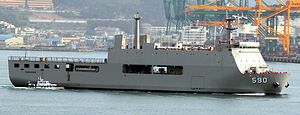It is well understood that the amphibious warfare vessel, as a general type, has spread across navies around the Indo-Pacific and beyond. The U.S. Navy pioneered the form, which combines a flight deck and amphibious landing capability in the same vessel. Such ships have become radically more common over the past two decades, in large part because they can fulfill multiple roles for a navy. Perhaps unsurprisingly, an export market for amphibious warships has developed as demand has increased. At the higher end of the export market is the Juan Carlos I family, currently consisting of one Spanish, one Turkish, and two Australian ships. These 27,000 ton vessels can carry multiple helicopters along with a contingent of vehicles and marines, and even offer a degree of naval strike capability for navies that can invest in the F-35B.
At the lower end sit the Makassar-class LPDs, modestly sized at 11,000 tons full displacement. Representing one of the first and best efforts at developing a cheap, on-the-go amphib for a discerning customer on a budget, the Makassars have been built in several countries to a South Korean design. With a robust shipbuilding industry, a strong international reputation on the arms export market, and an advanced technological base, South Korea was ideally positioned to take advantage of the burgeoning market in small amphibs. Shipyards around the world have laid down 10 of these small amphibs, with seven already in service. Customers include Indonesia, the Philippines, Peru, and Myanmar. Two of the five Indonesian ships and the Myanmar ship were built in South Korea, with the others constructed in their home countries after technical assistance from and licensing agreements with the ROK.
While small by the standards of the United States or NATO, the Makassars represent a genuine increase in capabilities for many small navies. They can carry up to 40 infantry vehicles, some 200 troops, two vehicle landing craft, and five helicopters. While the ships lack sophisticated defenses, they carry enough guns to give pirates or small boats an awfully bad day. These characteristics go well beyond the amphibious capabilities that most of the navies that have acquired the Makassar previously enjoyed. Moreover, the ships are flexible and can easily be re-equipped for HADR missions.
In the littoral of Southeast Asia, where maritime disasters are common, the Makassar offers a genuinely new defense profile. The ships can also contribute to policing and anti-piracy. Of even greater interest is the success of the type in South America, where not only Peru but also Brazil have announced interest. South American navies have been historically late to adapt to procurement trends in amphibious warfare, but along with Brazil’s acquisition of the former HMS Ocean this seems to be changing.
The Makassars are an almost classic example of industry stepping up to meet an anticipated naval need. Moreover, unlike many weapons systems the export of an LPD is essentially positive sum; the characteristics of the ship tend to produce benevolent follow-on effects in terms of anti-piracy and HADR. Altogether, the Maksassars are a significant victory for South Korea’s shipbuilding industry and defense industrial base.

































